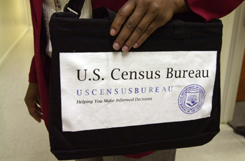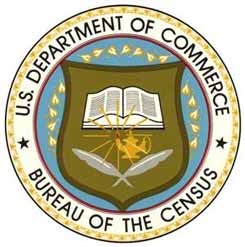
Federal statistical agencies use their own language when collecting, tabulating, and publishing Federal statistics. Terms and acronyms can become confusing quickly. Some of the critical terms are explained below.
CBSA - Core Based Statistical Area
The term (CBSA) became effective in 2000 and refers collectively to metropolitan and micropolitan statistical areas.
It's a statistical geographic entity consisting of the county or counties associated with at least one core (urbanized area or urban cluster) of at least 10,000 population, plus adjacent counties having a high degree of social and economic integration with the core as measured through commuting ties with the counties containing the core. Metropolitan and Micropolitan Statistical Areas are the two categories of Core Based Statistical Areas.
CD - Congressional district
An area established by law for the election of representatives to the United States Congress. Each CD is to be as equal in population to all other CDs in the state as practicable, based on the decennial census counts. The number of CDs in each state may change after each decennial census, and the boundaries may be changed more than once during a decade.
Census Block
The census block is smallest unit of geography for which Census 2000 data are tabulated. Census block data may be aggregated into any of the higher level geographic levels/areas. Census block data are only available for items covered on the complete count questionnaire.
Census Block Groups
The census block group (averaging approximately 1,000 population) is the smallest unit of geography for which sample-based (short-form) data were tabulated. It is not possible to aggregate block group units to all other types of geographic tabulation areas
FIPS codes - Federal Information Processing Standards Codes
Federal information processing standards codes (FIPS codes) are a standardized set of numeric or alphabetic codes issued by the National Institute of Standards and Technology (NIST) to ensure uniform identification of geographic entities through all federal government agencies. The entities covered include: states and statistically equivalent entities, counties and statistically equivalent entities, named populated and related location entities (such as, places and county subdivisions), and American Indian and Alaska Native areas. For Example, Colorado's FIPS code is 08.

MSA - Metropolitan Statistical Area
A Core Based Statistical Area associated with at least one urbanized area that has a population of at least 50,000. The Metropolitan Statistical Area comprises the central county or counties containing the core, plus adjacent outlying counties having a high degree of social and economic integration with the central county as measured through commuting.
Micropolitan Statistical Area
A Core Based Statistical Area associated with at least one urban cluster that has a population of at least 10,000, but less than 50,000. The Micropolitan Statistical Area comprises the central county or counties containing the core, plus adjacent outlying counties having a high degree of social and economic integration with the central county as measured through commuting.
Outside Core Based Statistical Areas
Counties that do not qualify for inclusion in a Core Based Statistical Area.
Urban Cluster
A statistical geographic entity to be defined by the Census Bureau for Census 2000, consisting of a central place(s) and adjacent densely settled territory that together contain at least 2,500 people, generally with an overall population density of at least 1,000 people per square mile. For purposes of defining Core Based Statistical Areas, only those urban clusters of 10,000 more population are considered.
Urbanized Area
A statistical geographic entity defined by the Census Bureau, consisting of a central place(s) and adjacent densely settled territory that together contain at least 50,000 people, generally with an overall population density of at least 1,000 people per square mile.
ZIP Codes and ZCTAs
ZIP Codes do not cover an easily definable area, nor do they have specific boundaries. ZCTAs were created by the Census Bureau to tabulate data for areas that approximated ZIP Codes.
ZIP Codes
ZIP Codes are established by the U.S. Postal Service (USPS) to expedite the delivery of mail.
ZIP Codes can represent an area within a state, an area that crosses state boundaries, or a single building or company that has a very high mail volume. Most delivery addresses are assigned a single ZIP+4 Code.
"ZIP" is an acronym for Zone Improvement Plan. +4: Describes the last four positions of a ZIP+4 Code. Large companies may be given a range of ZIP+4 Codes that can be used to route mail to a specific department.
ZCTAs
While it is common practice to refer to "ZIP Code areas," most ZIP Codes do not cover an easily definable area, nor do they have specific boundaries. Nevertheless, because data users want decennial census data for ZIP Codes, the U.S. Census Bureau first provided such data in conjunction with the 1990 census. However, rather than using census addresses to delineate ZIP Codes for that census, the Census Bureau purchased a file providing ZIP Code-to-census block comparability from a commercial firm; this file enabled the Census Bureau to tabulate data for areas that approximated ZIP Codes.
For Census 2000, the Census Bureau developed software that enabled it to assign, in an automated fashion, clusters of census blocks whose mailing addresses shared the same predominant ZIP Code, based on information stored in its own address file. The automated clustering was followed by a manual review and cleanup. However, because this clustering of blocks again only approximates ZIP Code delivery areas, the Census Bureau calls them ZIP Code tabulation areas, or ZCTAs. Because the approach for Census 2000 is essentially similar to the one used in the 1990 census - that is, ZIP Code data are based on tabulating data based on one or more census blocks - the Census Bureau estimates that performing the ZCTA identification, of itself, does not seriously affect the validity or comparability of the data. However, the coverage for the same ZIP-numbered area could be different because the USPS changed the coverage of many ZIP Codes and added new ZIP Codes since 1990. In addition, ZCTAs recognize ZIP Codes that are dedicated entirely to post office boxes in rural areas.
 Print
Print Email
Email








